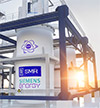Corporate Executive Survey Analysis: Media Trend of Onshoring Seems to be a Non-Issue for Most Corporations
The media trend of onshoring, however, seems to be a non-issue for most corporations participating in this survey. Despite the media coverage, 97 percent of the respondents do not expect to relocate a foreign facility back to the United States.
Winter 2012
Moving up on the list of site selection factors is the hotly contested issue of right-to-work. As I sit in my office overlooking downtown Indianapolis, the state of Indiana just voted to become the 23rd right-to-work state in the nation. This issue, as a site selection factor, jumped 9.6 percentage points, moving from 16th to 12th on the list, and is likely to be a trend companies and site selectors continue to monitor.
The media trend of onshoring, however, seems to be a non-issue for most corporations participating in this survey. Despite the media coverage, 97 percent of the respondents do not expect to relocate a foreign facility back to the United States. However, the survey does not determine how many of these companies have foreign facilities. In addition, 98 percent do not expect to relocate a domestic facility offshore either. Without further investigation, it is difficult to determine how many of the respondents to the survey have existing offshore facilities to even consider bringing them onshore.
Tied for second place on the list of site selection factors is availability of skilled labor, up from seventh place the prior year. Respondents say that high unemployment rates are not making it easier to find the labor their companies need (67 percent), and 43 percent say the unemployed are lacking both basic skills (reading comprehension and mathematical competency) and advanced skills (job-specific, technology-related, and specialized). Interestingly, training programs and proximity to technical college/training, as factors in the site selection process, rank near the bottom of the list - a 26-year trend.
Overall, the results are expected. Most corporations state economic instability (65 percent) as the top reason that they are not spending more of their earnings on investment in U.S. facilities. If they are relocating, high taxes are stated as the number-one reason behind the relocation, and the investment amount in new domestic facilities hovers under $10 million. With these corporations not confident that the economy will recover until 2014 (43 percent), it is presumable that we will continue to see actions that can result in the lowering of operating costs and labor costs, until something that resembles more traditional economic growth returns to the United States.
Project Announcements
Australia-Based Aquatic Leisure Technologies Group Plans Opp, Alabama, Manufacturing Operations
12/11/2025
Teradyne Plans Wixom, Michigan, Robotics Operations
12/11/2025
Robinson Plans Altoona, Iowa, Manufacturing Operations
12/11/2025
BioTouch Expands Columbus, Georgia, Operations
12/11/2025
Natrion Plans Erie County, New York, Battery Components Operations
12/11/2025
Czech-Based GZ PrintPak Expands Mount Pleasant, Wisconsin, Manufacturing Operations
12/11/2025
Most Read
-
The Workforce Bottleneck in America’s Manufacturing Revival
Q4 2025
-
Rethinking Local Governments Through Consolidation and Choice
Q3 2025
-
Lead with Facts, Land the Deal
Q3 2025
-
How Canada Stays Competitive
Q3 2025
-
Investors Seek Shelter in Food-Focused Real Estate
Q3 2025
-
America’s Aerospace Reboot
Q3 2025
-
The Permit Puzzle and the Path to Groundbreaking
Q3 2025



